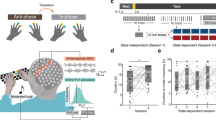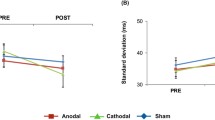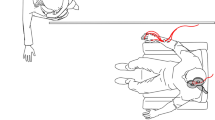Summary
In 15 musicians, cortical DC-potentials were recorded from the scalp before and during the execution of bimanual motor sequences. Subjects (Ss) either tapped with their two index fingers in synchrony (quavers against quavers; “2 against 2”) or they tapped quavers against triplets (“2 against 3”). Either the right or the left finger started tapping the quavers (onset time t1), after about 4 s the other finger joined in (t2) either with quavers as well (easy rhythm) or with triplets (difficult rhythm). Ss were free to start the sequences, i.e. to determine the onset times t1 and t2. Shifts of cortical DC potentials were averaged twice; (1) time-locked to t1 and (2) time-locked to t2. When moving in synchrony (easy rhythm) DC-potential shifts and maps of radial current densities across the scalp indicated activations of the two primary motor cortices (MI). When bimanually tapping different rhythms, there was not only an activation of MI cortices, but in addition a very large activation of the mesial, central cortex was observed. It is suggested that this cortical area which mainly contains the supplementary motor area (SMA) has the function of controlling the initiations of movements in the difficult sequence which have to fit into a very precise timing plan. Interestingly, activation of the mesial, central cortex preceded the actual performance of the difficult rhythm by about 4 s. This finding indicates that the preparatory set differs between the two tasks.
Similar content being viewed by others
References
Benecke R, Dick JPR, Rothwell JC, Day BL, Marsden CD (1985) Increase of the Bereitschaftspotential in simultaneous and sequential movements. Neurosci Lett 62: 347–352
Bernstein N (1984) Trends in physiology and their relation to cybernetics. In: Whiting HTA (ed) Human motor actions: Bernstein reassessed. North Holland, Amsterdam, pp 531–544
Chan JL, Ross ED (1988) Left-handed mirror writing following right anterior cerebral artery infarction: evidence for nonmirror transformation of motor programs by right supplementary motor area. Neurology 38: 59–63
Cheyne D, Weinberg H (1989) Neuromagnetic fields accompanying unilateral finger movements: pre-movement and movement-evoked fields. Exp Brain Res 78: 604–612
Cheyne D, Kristeva R, Lang W, Lindinger G, Deecke L (1989) Functional organization of sensori-motor cortex as revealed by magnetoencephalography. In: Ninth international conference on event-related potentials of the brain. EPIC IX, Conference Proceedings
Deecke L (1987) Bereitschaftspotential as an indicator of movement preparation in supplementary motor area and motor cortex. In: Porter R (ed) Motor areas of the cerebral cortex. Ciba Foundation symposium 132. Wiley, Chichester, pp 231–250
Deecke L, Kornhuber HH, Lang W, Lang M, Schreiber H (1985) Timing function of the frontal cortex in sequential motor and learning tasks. Human Neurobiol 4: 143–154
Deutsch D (1978) The psychology of music. In: Carterette EC, Friedman MP (eds) Handbook of perception: perceptual coding, Vol 8. Academic Press, New York, pp 204–208
Foerster O (1936) Motorische Felder und Bahnen. In: Bumke O, Foerster O (eds) Handbuch der Neurologie, IV. Springer, Berlin, pp 1–448
Gantchev GN, Kristeva R, Stambolieva E (1987) In: Proceedings of the fourth Conference of the International Organization of Psychophysiology, Prague
Gevins AS (1987) Overview of computer analysis. In: Gevins AS, Reymond (eds) Handbook of electroencephalography and clinical neurophysiology, Vol 1. Methods of analysis of brain electrical and magnetic signals. Elsevier, Amsterdam, pp 31–83
Goldberg G (1985) Supplementary motor area structure and function: review and hypothesis. Behav Brain Sci 8: 567–616
Hjorth B (1975) An on-line transformation of EEG scalp potentials into orthogonal source derivations. Electroenceph Clin Neurophysiol 39: 526–530
Jonas S (1981) The supplementary motor region and speech emission. J Commun Disorders 14: 349–373
Keele SW (1968) Movement control in skilled motor performance. Psychol Bull 70: 387–403
Kelso JAS, Putnam CA, Goodman D (1983) On the space-time structure of human interlimb co-ordination. Q J Exp Psychol 35A: 347–375
Kinsbourne M (1981) Single-channel theory. In: Holding D (ed) Human skills. Wiley, Chicester, pp 65–89
Klapp ST (1979) Doing two things at once: the role of temporal compatibility. Memory Cognition 7: 375–381
Kornhuber HH (1984a) Attention, readiness for action, and stages of voluntary decision: some electrophysiological correlates in man. Exp Brain Res Suppl 9: 420–429
Kornhuber HH (1984b) Mechanisms of voluntary movement. In: Prinz W, Sanders AF (eds) Cognition and motor processes. Springer, Berlin Heidelberg, pp 164–173
Kornhuber HH, Deecke L, Lang W, Lang M, Kornhuber A (1989) Will, volitional actions, attention and cerebral potentials in man: Bereitschaftspotential, performance-related potentials, directed attention potential and EEG spectrum changes. In: Hersberger W (ed) Volitional actions. Advances in Psychology. Elsevier, Amsterdam, in press
Kristeva R, Cheyne D, Lang W, Lindinger G, Deecke L (1989) Movement-related potentials accompanying unilateral and bilateral simultaneous movements with different inertial loads. Electroenceph Clin Neurophysiol (in press)
Lang W, Lang M, Podreka I, Steiner M, Uhl F, Suess E, Mueller C, Deecke L (1988a) DC-potential shifts and regional cerebral blood flow reveal frontal cortex involvement in human visuomotor learning. Exp Brain Res 71: 579–587
Lang W, Lang M, Uhl F, Koska Ch, Kornhuber A, Deecke L (1988b) Negative cortical DC shifts proceeding and accompanying simultaneous and sequential finger movements. Exp Brain Res 71: 579–587
Lang W, Oldenkott B, Goldenberg G, Reisner Th, Deecke L (1988c) Disturbed performance of motor sequences in patients with chronic lesions of the supplementary motor area (SMA). Congress of the International Medical Society of Motor Disturbances (ISMD), Conference Proceedings
Lang W, Zilch O, Koska C, Lindinger G, Deecke L (1989) Negative cortical DC shifts preceding and accompanying simple and complex sequential movements. Exp Brain Res 74: 99–104
Lashley KS (1951) The problem of serial order in behavior. In: Jeffress LA (ed) Cerebral mechanisms in behavior. Wiley, New York
Lehmann D (1984) EEG assessment of brain activity: spatial aspects, segmentation and imaging. Int J Psychophysiol 1: 267–276
Lindinger G, Lang W, Obrig H, Kristeva R, Deecke L (1990) Topographical analyses of radial current density. Distribution of cortical DC-activation in motor tasks. In: Brunia CHM, Gaillard AWK, Kok A, Mulder G, Verbaten MN (eds) Proceedings of the ninth international conference on event-related potentials of the brain. EPIC IX, Tilburg University Press, Tilburg (in press)
Massion J, Viallet F, Massarino R, Khalil R (1989) Coordination between posture and movement in parkinsonism and SMA lesion. In: Deecke L, Eccles JC, Mountcastle VB (eds) From neuron to action. International symposium in honour of the 60th birthday of HH Kornhuber. Springer, Heidelberg (in press)
Neshige R, Lüders H, Shibasaki H (1988) Recording of movement-related potentials from scalp and cortex in man. Brain 111: 719–736
Nunez P (1981) Electric fields of the brain: the neurophysics of EEG. Oxford University Press, Oxford
Oldfield RC (1971) The assessment and analysis of handedness: the Edinburgh inventory. Neuropsychologia 9: 97–113
Peters M (1981) Attentional asymmetries during concurrent bimanual performance. Q J Exp Psychol 33a: 95–103
Perrin F, Bertrand O, Pernier J (1987) Scalp current density mapping: value and estimation from potential data. IEEE Trans Biomed Eng, BME-34: 238–288
Sasaki K, Gemba H (1982) Development and change of cortical field potentials during learning processes of visually initiated hand movements in the monkey. Exp Brain Res 48: 429–437
Shibasaki H, Barret G, Halliday E, Halliday AM (1980) Components of the movement-related cortical potential and their scalp topography. Electroenceph Clin Neurophysiol 49: 213–226
Sternberg S, Monsell S, Knoll RL, Wright CE (1978) The latency and duration of rapid sequences: comparisons of speech and typewriting. In: Stelmach G (ed) Information processing in motor control and learning. Academic Press, New York
Tanji J (1984) The neuronal activity in the supplementary motor area of primates. Trends Neurosci 7: 282–285
von Holst E (1939) Die relative Koordination als Phänomen und als Methode zentralnervöser Funktionsanalyse. Ergebn Physiol 42: 228–306
Author information
Authors and Affiliations
Rights and permissions
About this article
Cite this article
Lang, W., Obrig, H., Lindinger, G. et al. Supplementary motor area activation while tapping bimanually different rhythms in musicians. Exp Brain Res 79, 504–514 (1990). https://doi.org/10.1007/BF00229320
Received:
Accepted:
Issue Date:
DOI: https://doi.org/10.1007/BF00229320




